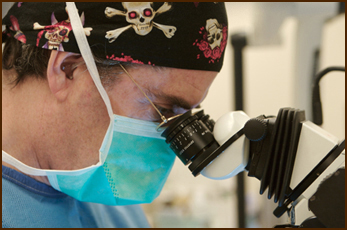State-Of-The-Art
Innovation & Technology
Neurosurgery is a complex specialty requiring skill, experience, and complete familiarity with the patient and their condition. As innovation allows for more options, a thorough knowledge of most current technology will optimize results. Dr. Miller has contributed to innovations in the field, namely Laser Doppler Flowmetry (LDF). In addition, he continues to be a leader in neurosurgery by adopting and employing new surgical techniques himself, specifically Frameless Stereotactic Imaging, chemotherapy wafer implants, and the dorsal column stimulator for pain management. These innovations are now being employed by many leading neurosurgeons because of their significant value toward the best surgical outcomes.
Frameless Stereotactic Surgery
Stereotactic surgery is a technique that uses images of the brain that allow the surgeon to navigate to a specific spot in the brain. When advances in computed tomography (CT) and magnetic resonance imaging (MRI) occurred, this technique became possible. Early on, stereotactic surgery was performed using a frame that was attached to the patient’s head under local anesthesia.
With continued advances in computer technology, the idea of frameless stereotactic surgery developed. This method uses markers taped to the patient’s scalp, instead of the stereotactic head frame, before the brain is imaged. Today, it is common practice across the United States to use frameless stereotactic surgery for both cranial and spinal neurosurgical procedures.
Frameless stereotactic surgery in cranial and spinal procedures has many advantages over traditional methods for surgeons and, most importantly, for patients. Advantages for cranial procedures include:
-
Smaller incisions and craniotomies; which may lead to quicker recovery
-
Less invasive excisions, which may lead to improved patient outcomes;
-
Less patient discomfort from having to wear a stereotactic frame to and from the CT or MRI unit and OR;
-
Less preparation time than framed stereotactic surgery because the frame does not need to be applied to the patient and calculations do not need to be made in the CT or MRI unit;
-
Easier use with pediatric patients, as less cooperation is needed.
Advantages for spinal procedures include:
-
Reduction and possible elimination of radiation exposure during surgery;
-
Improvement of hardware placement accuracy, providing better patient outcomes;
-
Reduced surgical procedure time by making hardware placement decisions more efficient.
Laser Doppler Flowmetry (LDF)
Laser Doppler Flowmetry (LDF) is a recent technique that is increasingly being used to monitor relative changes in cerebral blood flow. Laser doppler assessment of cerebral blood flow is used in conjunction with other techniques for monitoring of head injured patients.
Raised intracranial pressure (ICP) and low cerebral blood flow (CBF) are two factors associated with ischemia (loss of blood to brain tissue) and poor outcome after brain injury. In contrast to most other organs, the brain is protected by a stiff skull. An increase in ICP may impede cerebral blood flow (CBF) and cause ischemia. Raised ICP is an important secondary injury in brain-injured patients and a predictor of poor outcome after traumatic brain injury. It is used as a target in many treatment plans.
Chemotherapy Wafers
Malignant gliomas are the most common primary brain tumor, accounting for more than half of the more than 18,000 primary malignant brain tumors diagnosed each year in the United States.
Wafer implants are a new way of applying chemotherapy directly to brain tumors. The wafer, approximately the size of a dime, is made of gel that contains carmustine (BCNU), a chemotherapy drug. During brain surgery to remove some or all of a tumor, up to 8 wafers are placed in the space where the tumor was. Over the next few days, the wafers slowly release the chemotherapy agent into this area. The wafers dissolve between 2 to 3 weeks after they are put in.
Some clinical trials have shown that using chemotherapy wafers as well as surgery and radiotherapy helps people with glioma live longer. At the moment wafers are indicated for patients with either high-grade malignant glioma, or glioblastoma multiforme which has come back after treatment.
Studies so far have shown that people who have chemotherapy wafers manage with them quite well although they do have side effects.
Dorsal Column Stimulator
A Dorsal Column Stimulator (DCS) is an implantable medical device used to treat chronic pain of neurologic origin in the back, trunk, or limbs. An electric impulse generated by the device near the dorsal surface of the spinal cord provides a tingling sensation that alters the perception of pain by the patient. A pain medicine specialist or a surgeon introduces the spinal cord stimulator lead into the epidural space either by percutaneous approach or by surgery. A pulse generator or radio frequency receiver is implanted in the abdomen or buttocks. A wire harness connects the lead to the pulse generator.
Since the first system was implanted in 1967, neurostimulation technology has undergone significant advancements, including refinements in patient selection criteria, and equipment design, flexibility, reliability, and lifespan.
The goal of neurostimulation is to reduce rather than eliminate pain. Published studies of the therapy have shown that when used on carefully selected chronic pain patients, neurostimulation may improve pain relief (at least 50% reduction in pain), increase activity levels, and reduce use of narcotic medications.


 x
x